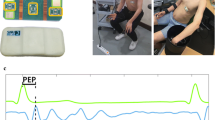Abstract
A continuous noninvasive method of systolic blood pressure estimation is described. Systolic blood pressure is estimated by combining two separately obtained components: a higher frequency component obtained by extracting a specific frequency band of pulse arrival time and a lower frequency component obtained from the intermittently acquired systolic blood pressure measurements with an auscultatory or oscillometric system. The pulse arrival time was determined by the time interval from QRS apex in electrocardiogram to the onset of photoplethysmogram in a fingertip beat-by-beat via an oximetric sensor. The method was examined in 20 patients during cardiovascular surgery. The estimated values of systolic blood pressure were compared with those measured invasively using a radial arterial catheter. The results showed that the correlation coefficients between estimated values and invasively obtained systolic blood pressure reached 0.97±0.02 (mean±SD), and the error remained within ±10% in 97.8% of the monitoring period. By using a system with automatic cuff inflation and deflation to acquire intermittent systolic blood pressure values, this method can be applicable for the continuous noninvasive monitoring of systolic blood pressure.
Similar content being viewed by others
References
Bazett, H. C., andDreyer, N. B. (1922): ‘Measurement of pulsewave velocity’,Am. J. Physiol.,63, pp. 94–115
Blacher, J., Asmar, R., Djane, S., London, G. M., andSafar, M. E. (1999): ‘Aortic pulse wave velocity as a marker of cardiovascular risk in hypertensive patients’,Hypertension,33, pp. 1111–1117
Callaghan, F. J., Geddes, L. A., Babbs, C. F., andBourland, J. D. (1986): ‘Relationship between pulse wave velocity and arterial elasticity’,Med. Biol. Eng. Comput.,24, pp. 248–254
Diourte, B., Siche, J. P., Comparat, V., Baguet, J. P., andMallion, J. M. (1999): ‘Study of arterial blood pressure by a Windkessel-type model: influence of arterial functional properties’,Comput. Methods Programs Biomed.,60, pp. 11–22
Geddes, L. A., Voelz, M. H., Babbs, C. F., Bourland, J. D., andTacker, W. A. (1981): ‘Pulse transit time as an indicator of arterial blood pressure’,Psychophysiology,18, pp. 71–74
Gribbin, B., Steptoe, A., andSleight, P. (1976): ‘Pulse wave velocity as a measure of blood pressure change’,Psychophysiology,13, pp. 86–90
Hamilton, W. F., Remington, J. W., andDow, P. (1945): ‘The determination of the propagating velocity of the arterial pulse wave’,Am. J. Physiol.,144, pp. 521–535
Hemingway, A., McSwiney, B. A., andAllison, P. R. (1928): ‘The extensibility of human arteries’,Quart. J. Med.,21, pp. 489–498
Hickson, S. K., andMcSwiney, B. A. (1924): ‘The effect of variations in blood pressure on pulse wave velocity’,J. Physiol.,19, pp. 217–230
Hon, E. H., andFukushima, T. (1992): ‘R-pulse wave timing in cardiovascular monitoring: further observations’,Obstet. Gynecol.,79, pp. 597–600
Hughes, D. J., Babbs, C. F., Geddes, L. A., andBourland, J. D. (1979): ‘Measurement of Young's modulus of elasticity of the canine aorta with ultrasound’,Ultrasonic Imaging,1, pp. 356–367
Lansdown, M. (1957): ‘A method of using induced waves to study pressure propagation in human arteries’,Circ. Res.,5, pp. 594–601
Lu, W., Li, H., Tao, S., Zhang, D., Jiang, Z., Cui, L., Tu, J. andGou, D. (1992): ‘Research on the main elements influencing blood pressure measurement by pulse wave velocity’,Front. Med. Biol. Eng.,4, pp. 189–199
Lyon, D. M., andSands, J. (1925): ‘Studies in pulse wave velocity’,Am. J. Physiol.,71, pp. 534–542
Mackay, R. S. (1964): ‘The application of physical transducer to intracavity measurement, with special application to tonometry’,Med. Electron. Biol. Eng.,2, pp. 3–17
Murray, W. B., andFoster, P. A. (1996): ‘The peripheral pulse wave: Information overlook’,J. Clin. Monitoring,12, pp. 365–377
Nye, E. R. (1964): ‘The effect of blood pressure alteration on the pulse wave velocity’,Br. Heart. J.,26, pp. 261–265
Pitson, D. J., andStradling, J. R. (1998): ‘Value of beat-to-beat blood pressure changes, detected by pulse transit time, in the management of the obstructive sleep apnoea/hypopnoea syndrome’,Europ. Respirat. J.,12, pp. 685–692
Pruett, J. D., Bourland, J. D., andGeddes, L. A. (1988): ‘Measurement of pulse-wave velocity using a beat-sampling technique’,Ann. Biomed. Eng.,16, pp. 341–347
Remington, J. W. (1961): ‘The physiology of the aorta and major arteries’, Chapter 24,Handb. Physiol., pp. 799–838
Steele, J. M. (1937): ‘Interpretation of arterial elasticity from pulse wave velocity’,Am. Heart. J.,14, pp. 452–465
Steptoe, A., Smulyan, H., andGriffin, B. (1976): ‘Pulse wave velocity and blood pressure change: Calibration and applications’,Psychophysiology,13, pp. 488–493
Tanaka, H., Sakamoto, K., andKanai, H. (1984): ‘Indirect blood pressure measurement by the pulse wave velocity method’,Jap. J. Med. Electron. Biol. Eng.,22, pp. 13–18
Williams, J. G. L., andWilliams, B. (1965): ‘Arterial pulse wave velocity as a psychophysiological measure’,Psychosom. Med.,27, pp. 408–414
Wippermann, C. F., Schranz, D., andHuth, R. G. (1995): ‘Evaluation of the pulse wave arrival time as a marker for blood pressure changes in critically ill infants and children’,J. Clin. Monitoring,11, pp. 324–328
Yamakoshi, K., Shimazu, H., andTogawa, T. (1980): ‘Indirect measurement of instantaneous arterial blood pressure in the human finger by the vascular unloading technique’,IEEE Trans.,BME-27, pp. 150–155
Author information
Authors and Affiliations
Corresponding author
Rights and permissions
About this article
Cite this article
Chen, W., Kobayashi, T., Ichikawa, S. et al. Continuous estimation of systolic blood pressure using the pulse arrival time and intermittent calibration. Med. Biol. Eng. Comput. 38, 569–574 (2000). https://doi.org/10.1007/BF02345755
Received:
Accepted:
Issue Date:
DOI: https://doi.org/10.1007/BF02345755



